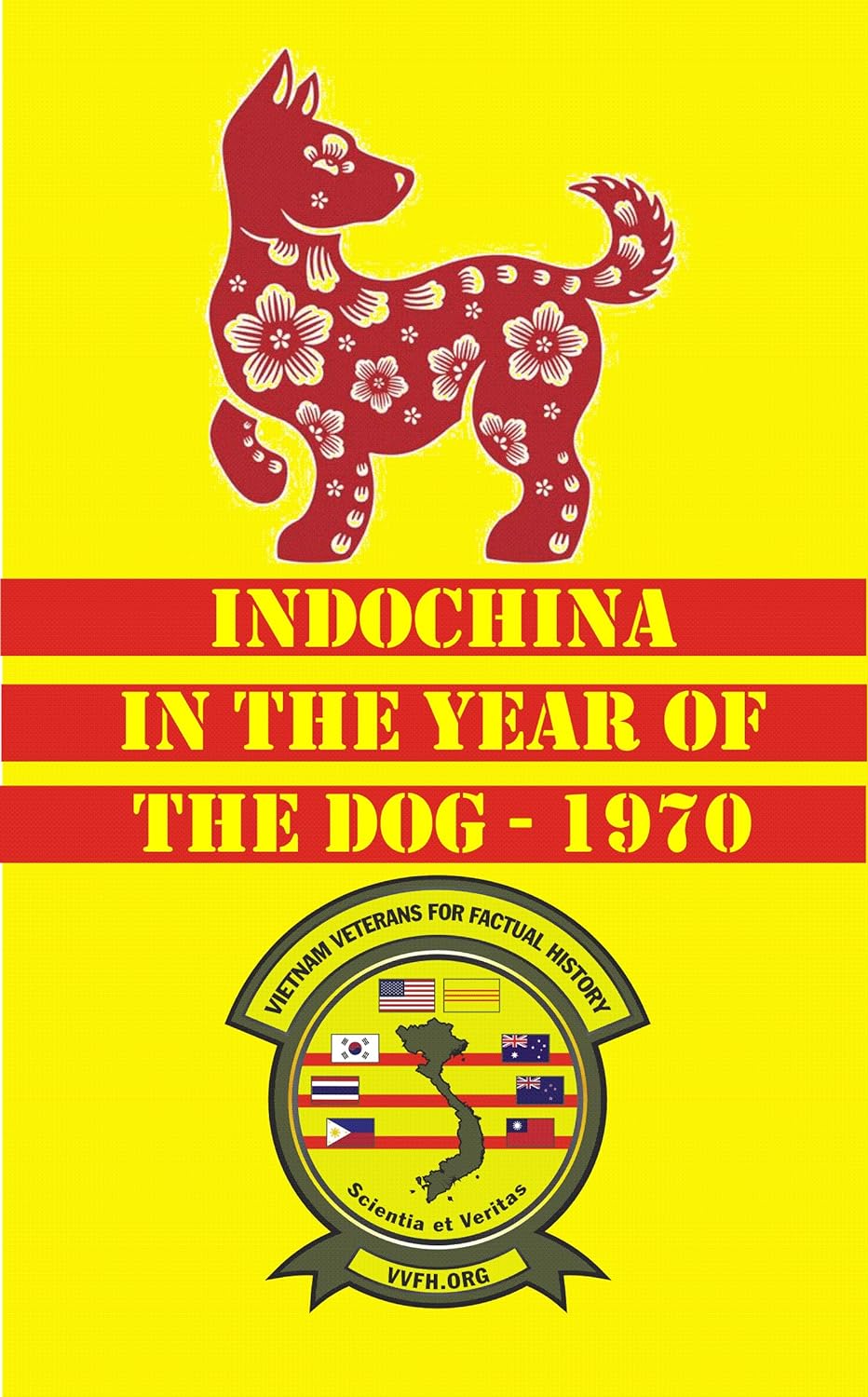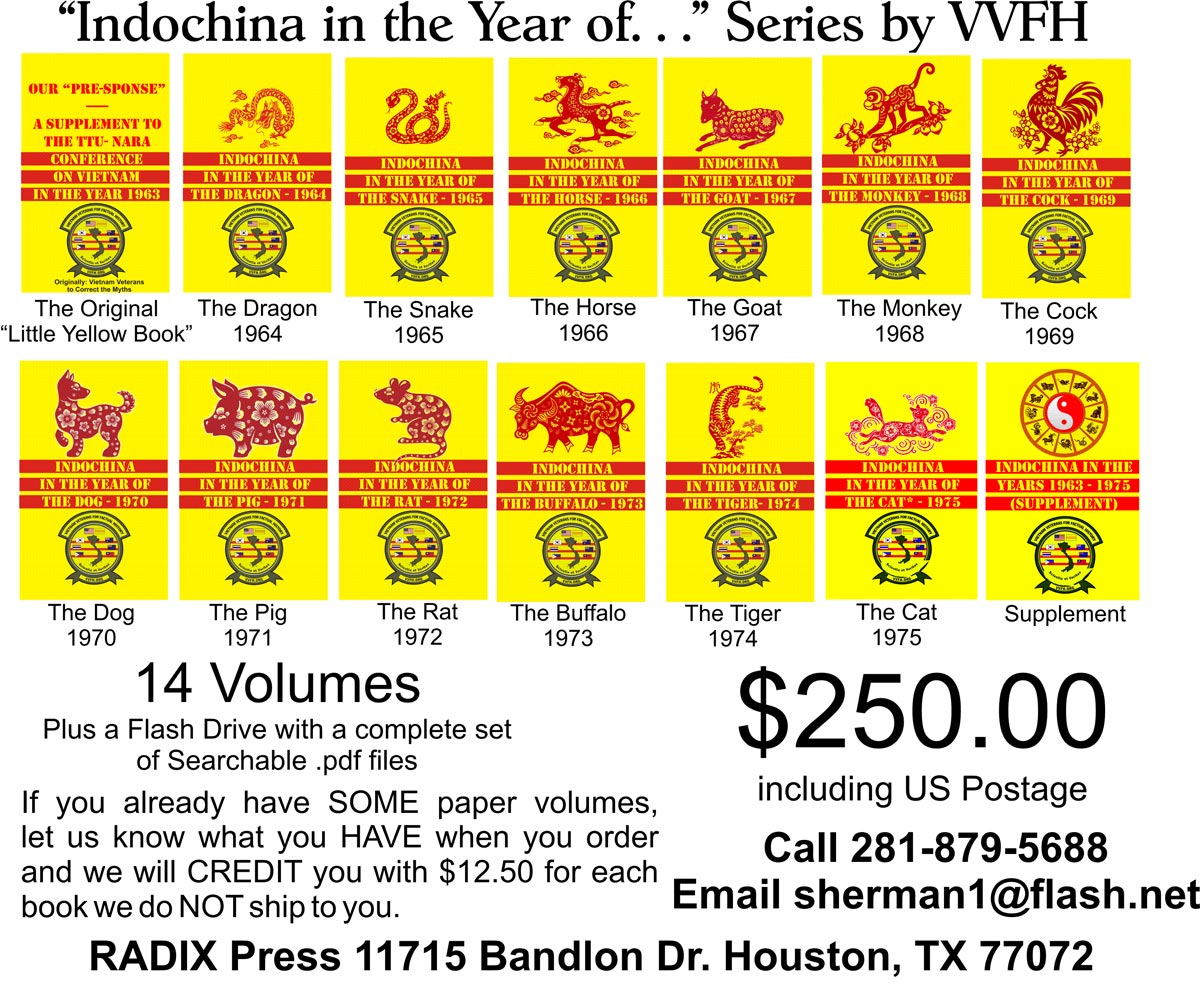Book Review
Indochina in the Year of the Dog – 1970
by Vietnam Veterans for Factual History (VVFH)
RADIX Press

91-NgnY6UgL._SL1500_
By How Miller
Former Green Beret Steve Sherman has helped many of us over the years locate teammates and others. He has, through his lifelong efforts, become the unofficial historian for Special Forces. His website, www.specialforcesbooks.com, can take you immediately to a search for the personnel at the locations where you served in Vietnam or lead you to many of his other websites, CDs, and publications.
Somewhere in the middle of all this, he decided to gather a history of our involvement in what the French called Indochina. He picked 1963, the year of the Cat, to collect stories and reporting that explained what was going on that year and why. The book was a resounding success and he and his team put together 14 books. I was able to procure a single book: Indochina in the Year of the Dog – 1970, because that was the year I spent most of my time in Vietnam and Cambodia.
This volume is packed with information, an in-depth look at the subjects, and historical background for you to get a greater understanding of what was going on. The scene was set with a piece from MACV Command History in “The Situation in 1970.” Then we see the entire career of Norodam Sihanouk, starting as a young royal, through his various titles and loyalties, ending up as the father of the Cambodian king, and dying in Beijing in 2012. The author, Tan Dara Thach, had been a high-ranking officer in the Cambodian Army (FANK) until 1975.
That led logically to Lewis Sorley’s “Cambodian Campaign”, which my camp participated in, and how that success contributed to the maturation of the South Vietnamese Armed Forces and the entire pacification program. Later, Lewis tells of two entirely opposite efforts to bring citizens together in the rural pacification program, where they could once again be in charge of their own lives and deny the enemy a safe haven. First was Ambassador Komer, who made efforts but faced heavy criticism for promoting the idea of pacification but not actually accomplishing it. He was replaced by General Creighton Abrams, who brought in William Colby, a former OSS Jedburgh leader in France in WWII. Colby did most everything the right way, spending lots of time in the field listening to the Vietnamese farmers, for instance, and guiding his efforts toward helping them fulfill their dreams while defending themselves from the enemy. By the end of 1970, the pacification program was a resounding success.
Another theme explored is the anti-war movement, starting with Roger Canfield and Robert Turner writing about the incident at Kent State, including a surprising, in-depth look at how the shooting started. That was later followed by a detailed look by Roger at the many whose actions were in sync with what the Vietnamese Communists were trying to accomplish. Many of the activities were funded or subsidized by communist organizations. There are many familiar names, such as the Weather Underground, Black Panthers, Jane Fonda, Huey Newton, Noam Chomsky, and an alphabet soup of acronyms like COLIFAM and CPUSA, the americong, trips to communist countries, and broadcasts on Radio Hanoi.
Throw in some North Vietnamese spies like Pham Xuan An talking to reporters hanging around the bars in Saigon, waiting to be fed stories, and there was a lot going on to sour the American public on the war that we were actually winning.
Then we are treated to scintillating tales of SF raids. Operation Tailwind, by SOG veteran and author John Stryker Meyer, is about a highly successful raid deep into Laos to help a CIA operation get the enemy off their backs. The other, by Mike Benge, tells of the Son Tay Raid to rescue American POWs from a prison fairly near Hanoi. Masterfully planned and executed, including a fallback adjustment even though the POWs had recently been moved elsewhere, resulted in other benefits. POWs were suddenly treated somewhat better, and morale improved because we had tried. In their own words, they knew they weren’t forgotten.
Fred Benson worked in Laos from 1968 to 1974. In “Battle for Sam Neua Province,” he relates a complicated but understandable history of Laos from the 1950s on (part 1 through 1965). He fills in so many details as to make sense of events leading to the SF Operation White Star and later SOG. The US wanted, at the very least, for the poorly equipped Laos to remain a functioning neutral buffer between Thailand and North Vietnam. Several attempts to help them accomplish that were foiled by the communists, and ultimately all parties ended up pretending that Laos actually was neutral, while both sides warred incessantly.
It wraps up with a plea for honest reporting of the war and an invitation to us (the participants) to be heard, acting as witnesses to what we actually experienced.
This is just the year 1970. There is a whole series of books from 1963 to 1975 with tons of eye-opening, scholarly content. You can find the table of contents for each book at https://www.vvfh.org/index.php/books/e-bookstore/indochina-year-books, and ways to purchase, including a fantastic deal for the whole printed set.
Each of the series’ years is summarized here.
1963: Our Pre-Sponse: A Supplement to the TTU-NARA Conference on Vietnam in the Year 1963 was the first of the series of Yellow Books, a series of books that covered each year in detail.
1964: Indochina in the Year of the Dragon was an eventful year with events like the Tonkin Gulf Resolution, the unraveling of the Geneva Accords, the Brinx Hotel Bombing, and much more.
1965: Indochina in the Year of the Snake volume covers the events of 1965, including Nguyen Cao Ky, the landing of the Marines, poison gas, Agent Orange, and many other issues.
1966: Indochina in the Year of the Horse covers the events of 1966, including the helicopter war, Hanoi’s political war inside the United States, the battle of A Shau, and much more.
1967: Indochina in the Year of the Goat covers the events of 1967, including Westmoreland’s myths, the Thirteenth Plenum, intelligence, missed opportunities, and much more.
1968: Indochina in the Year of the Monkey covers the events of the pivotal year of 1968, including the Tet Offensive, the battle in Hue and the massacre that occurred there, and much more.
1969: Indochina in the Year of the Cock covers the events of 1969, including Nixon’s approach to the war, Hamburger Hill, and the involvement of North Korea and China in the war.
1970: Indochina in the Year of the Dog covers the events of 1970, including the Son Tay raid, the Cambodian campaign, Kent State, and much more.
1971: Indochina in the Year of the Pig covers the events of 1971, including Lam Son 719, the Pentagon Papers, graft and corruption, and the peace movement.
1972: Indochina in the Year of the Rat covers the events of the year 1972, including the Easter Offensive, An Loc, Linebacker I and II, and much more.
1973: Indochina in the Year of the Water Buffalo covers the events of 1973, including Operation Homecoming—the release of the POWs, Land to the Tiller, and the false peace of the treaty.
1974: The Year of the Tiger covers the events of 1974, including writers of the Republic of Vietnam, China’s relationship with Laos, Hanois strategic thinking, and more.
1975: Indochina in the Year of the Cat covers the events of the fateful year of 1975, when Vietnam, Laos, and Cambodia fell under communist control and millions of people died.
1963–75: Indochina in the Year of the Years 1963–1975 (Supplement) covers topics spanning the entire period of American involvement in Vietnam, including topics they were unable to include in the individual yearbooks.
About the Author:
How Miller has served as the editor of Chapter 78’s Sentinel since January 2021. Read How’s Member Profile to learn more about him.


Leave A Comment